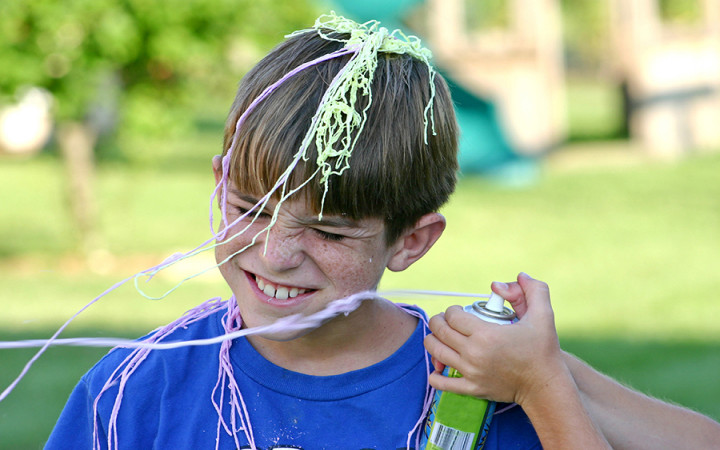Today’s Wonder of the Day was inspired by Roc. Roc Wonders, “How do they make silly string?” Thanks for WONDERing with us, Roc!
What is the perfect way to celebrate Halloween or a birthday with your friends? If you're like many kids, the answer to that question is simple. You just want to be set free in a large backyard with an infinite supply of aerosol cans that shoot colorful blasts of foamy strings. What are we talking about? Silly String, of course!
Generically referred to as aerosol string or spray streamer, Silly String was invented by Robert P. Cox and Leonard A. Fish. It was patented in 1972 by Wham-O Manufacturing Company, which is also famous for its Hula Hoop and Frisbee. Today, Silly String is made by Just for Kicks, a division of Car-Freshner Corporation, which is known for its automobile air fresheners shaped like trees.
If you've ever played with Silly String, you know how much fun it can be. A simple press of the nozzle on the top of the aerosol can results in a long string of foamy plastic shooting across the room…and usually onto a friend. The strings of plastic foam are very light, but they hold together and can stick to surfaces, including people and walls.
How does a liquid inside an aerosol can turn into foamy plastic strings that shoot through the air? Is it magic? Nope! It's just chemistry.
The exact formula for the chemical mixture inside a can of Silly String is a closely-held secret. However, scientists who have studied the original 1972 patent have a fairly-good idea of the types of chemicals involved and what they do.
When you press the nozzle of a Silly String can, a difference in pressure is created that allows a chemical propellant to push the liquid chemical mixture inside the Silly String can through a thin tube into the air. The chemicals react together to form lightweight foam that's surrounded by a flexible and slightly-sticky plastic skin.
There are three main ingredients involved. A resin forms the sticky plastic coating of the strings. A surfactant makes the resin foam and become sticky. The propellant forces the chemicals out of the can, helping them to foam and mix together as it evaporates. Propellant accounts for about 75% of the liquid inside a can of Silly String.
Silly String also contains a few other ingredients that add to its unique composition. Plasticizers make the strings longer, while silicone liquids make the strings easier to clean-up. Various pigments are added to give the strings specific colors. Finally, flame retardants are included to make sure the strings are non-flammable.
Despite efforts to make Silly String both fun and easy to remove, some cities have banned the use of Silly String at certain celebrations and on particular holidays, such as Halloween. Nevertheless, it remains a popular product with kids of all ages.
It's popular with more than just kids, though. Over the past decade, military units have found a very practical use for Silly String: detecting dangerous trip wires. In Iraq, for example, soldiers use Silly String before entering a building that they suspect could contain a bomb.
It's very hard to detect nearly-invisible trip wires that detonate a bomb when triggered. Soldiers shoot Silly String across a room before entering. If it all falls to the ground, they know it's safe to enter. If it hangs in the air, however, they know it's caught on a trip wire and they can avoid triggering explosives.





